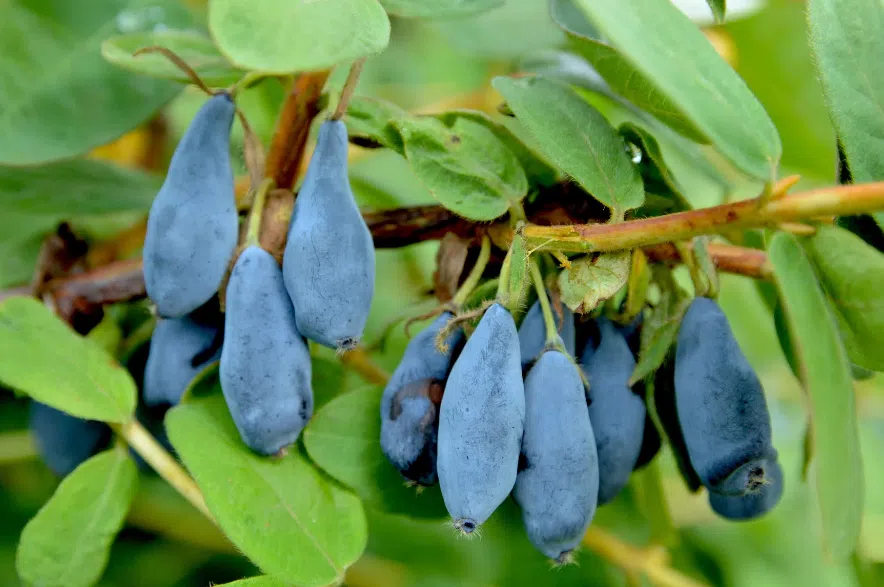Jill and Rick Van Duyvendyk answer all your gardening questions in Garden Talk on 650 CKOM and 980 CJME every Sunday morning at 9 a.m. Here are some questions and answers from the June 1 show:
Read more:
- Garden Talk: How can I stop voles invading a garden bed?
- Garden Talk: Tips for planning a thriving home vegetable garden
- Garden Talk: Save money by being water wise in your yard this summer
These questions and answers have been edited and condensed for clarity.
Q: Can Saskatoons or choke cherries be affected by wildfire smoke?
A: The only thing the smoke really affects is its ability to breathe. It coats the plants, but under most conditions it’s not going to affect them.
It probably could affect the taste of the fruit when it is ripening but it’s pretty early right now for most of our berries except for haskaps, which will be ripening in another couple of weeks. It might add a smoky taste to jam.
Q: Can I transplant a tiny oak tree?
A: Absolutely, just make sure that you take a good shovel of dirt with it. Oak trees put down a taproot, which is a root that goes straight down, to find moisture. That’s why they’re a good drought tree.
If you’re going to transplant it on a different property dig it out and slide it
into a pot, then give it some water and put in the shade but when you take it out of the pot, you have to be careful to keep the soil around the roots. You can even wrap it with burlap to hold that root or put the burlap into the pot so you can lift the plant out easier.
If you want, you can put some starting fertilizer and keep it moist and you’ll be fine. Okay. PureAg PureBLUE Ericoid Mycorrhizal Fungi always is good. It works to get the roots going because it’s a phosphorous fixing mycorrhizum and makes the roots go like crazy. H-Start probiotic works really well, too.
Q: How can I deal with scarlet lily leaf beetles?
A: Look on the underside of the leaves — you’ll see little rows of orange eggs you need to take off. A lint brush works well, just roll it up the backside of the leaf or pick them off with your fingernail with dish underneath to catch them and then throw them out.
You can also use a product called Bug Out but you have to spray the underside of the leaves only. Do not spray the the buds or the flowers.
You need to keep on top of it because once they hatch the beetle goes into the soil and that’s where it will stay and emerge to chew on your leaves. And they reproduce quickly so check them every day.
Q: What causes my lilac branches to be weak and break?
A: They need nutrients and lilacs don’t like to be too wet, they want to be just moist. Use a piece of rebar to probe the soil. Any hardware place has 3/8th rebar, and it has ribs on the side. Check down about six or eight inches, the soil should be just moist when you pull it up. It shouldn’t be bone dry or muddy or wet.
And lilacs love to be fertilized and pruned. As soon as the lilac stops blooming, prune and then fertilize. Whatever growth they put up in the next few weeks is what they’re gonna bloom on next year.
Q: I’ve purchased some diatomaceous earth to deter ugly white worms, but how do I apply it?
A: The worm is coming from ia sawfly type of a fly and it’ll lay the eggs on top of the plant. Once the eggs hatch they’ll just go right into the raspberries. So if you are using diatomaceous earth you need to put a bit of dampness on the raspberries so that it sticks to it.
Diatomaceous earth is mainly used on the ground. It’s like crushed up seashells so when an insect crawls through it, it gets into all their little joints and cuts them then they die.
Applying it on the plant itself, is really tough because it just wants to fall off, especially once it dries. If it’s a really bad infestation pick all the raspberries as they produce and pick them off before they ripen.
Q: How do I deal with canker worms?
A: The nests looks like a webbing. You can either cut that off and then put it on the ground and stomp on it or throw in the garbage.
You can also use a product called BTK. It’s a biological insecticide and just targets caterpillars. Once they eat the leaf it gives them a tummy ache and then they can’t eat any more and then they die.
For canker worms on big trees, spray with the BTK as much as you can. Around the September long weekend the moth comes up from the ground. The male can fly, but the female can’t and has to crawl up the trunk so put a band on the tree.
Use a piece of plastic to cover up all the cracks around the trunk and apply Tanglefoot. It’s a sticky substance and the moth can’t go up and lay its eggs for the next year. If you miss doing it in September, you can do it again in April, but take it off for the summer or it rots the bark.
Q: What should I use to I fertilize my vegetable garden?
A: Make sure you’re using a vegetable fertilizer that doesn’t have a ton of nitrogen and phosphorus, but does have a lot of micronutrients like calcium, zinc and boron so
you’re not forcing the growth, you’re just forcing healthy roots.
A higher nitrogen fertilizer will cause lots of growth and can cause the plant to bolt. Calcium is crucial for most plants, especially tomatoes, cucumbers, even beans and pumpkins and melons. Apply it once every two or three weeks.
Q: Should I remove flowers from newly planted June-bearing strawberries to establish a good root system?
A: If you have a lot of flowers you can thin some, but don’t take all of them. June-bearing strawberries produce for a shorter time, they’re not going to produce consistently throughout the season.
Strawberries send off runners, so the mother plant is actually not the plant that is going to produce lots of strawberries the following year, it’s actually those runners that are going to produce the berries.
Q: What causes potato plants to go yellow and dry up?
A: Most likely it is a moisture issue, you can get the same symptoms from plants being either too wet or too dry. It could also be from a heavy alkaline soil.
Potatoes don’t like too much manure because you’ll get potato scab but you can use a potato fertilizer with a higher sulfur content in it and potatoes love that.
Q: How do I fix a lawn where the pH level is about 7.8?
A: Start using a sulfur product or aluminum sulfate. You can also use Ground Keeper Lawn Fertilizer 16-10-3-17-3 or Ground Keeper Lawn Fertilizer Phos-Free 23-0-3-17-3. One’s a green bag and one’s an orange bag. Use the orange bag in summer, green bag is for the spring. Apply the aluminum sulfate with a hand or rotary spreader.
Watch the pH of your water, too, and keep doing a soil test. If you’re using
tap water for the test, you’re going to get a high result so use distilled water.
Q: What is the best way to start a new Virginia creeper plant from an existing one?
A: Do it in the summertime when you have a runner going along the ground. Throw a little bit of dirt right on top of them and it’ll actually root into that dirt. Later on, you can dig that piece out and transplant it.
Otherwise, you can take a softwood cuttings and plant it in a jiffy pot. You can also cut pieces off a root in the ground and start it that way, too.
Q: Can I fix a waterlogged flower hanging basket?
A: It might come back. Make sure you’re sticking your finger in the soil before you’re watering them and if there is any moisture in there leave it until it feels dry to the touch.
Also watch the bottom of the pot, sometimes it gets clogged. You can drill some holes into the bottom. Make sure that you’re allowing some airflow . All hanging baskets have a reservoir on the bottom that holds a little bit of water so tip it sideways to drain the excess water out of that reservoir each time after your water.
Q: How do I take care of a braided willow tree?
A: Braided willows are a tropical willow and have to be in a very sheltered area. If you want to grow them in a pot, let them go dormant in the fall, let the frost get the leaves and everything else off, then put them in a cool place in the basement and water sparingly so it doesn’t go bone dry. Most people enjoy them for a season and then dispose of them.
Read more:











